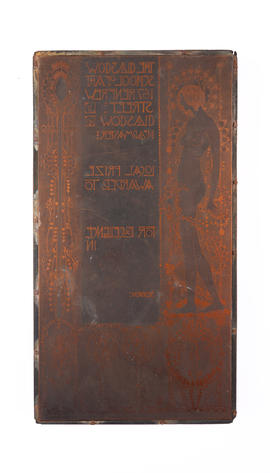Key Information
Reference code
Title
Date(s)
- c1900 (Creation)
Level of description
Item
Extent
1 item
Content and Structure
Scope and content
Printing block with Glasgow style female figure, stylised trees and flowers forming the border design.
Central text block with
- The Glasgow School of Art address
- Local prize awarded to:
- For excellence in:
- Session:
Appraisal, destruction and scheduling
Accruals
System of arrangement
General Information
Name of creator
Biographical history
King [married name Taylor], Jessie Marion (1875–1949), illustrator and designer, was born on 20 March 1875 at the manse, New Kilpatrick, Dunbartonshire, the third daughter of the Revd James Waters King (1836–1898), Church of Scotland minister, and his wife, Mary Ann (1846–1896), daughter of James(?) Anderson, baker and miller, of Lanark; a younger brother was born a year later. Educated at the parish school in New Kilpatrick until 1891, she took a course at Queen Margaret College, Glasgow, before studying at Glasgow School of Art from 1892 to 1899, under F. H. (Fra) Newbery, who led the school into a golden era. Fellow students included Helen Paxton Brown, Annie French, Ann Macbeth, and Katherine Cameron as well as Margaret and Frances Macdonald, who in 1896 with Charles Rennie Mackintosh and Herbert MacNair launched the influential ‘Glasgow style’ allied to European art nouveau.
As a student King developed her mannered mode of outline drawing, combining delicately patterned surfaces with nervous, elongated lines and arabesque forms within grid-like frames often containing lettering, influenced by Aubrey Beardsley, Jan Toorop, and the late graphic style of Burne-Jones. Early successes included a national silver medal (1898) for illustrations to Edwin Arnold's The Light of Asia (1879), despite the ‘excessive attenuation’ of her figures, a gold medal at the international exhibition of ‘Modern decorative art’ in Turin (1902), and a commission from the Berlin publishing firm Globus Verlag. Work for British publishers established her as a leading illustrator alongside Arthur Rackham, Kate Greenaway, and Laurence Housman. A checklist of items reveals nearly 300 design projects in sixty years, ranging from art books to advertising cards. Her preferred medium was pen and ink, with watercolour, on vellum, and favourite motifs included ships with billowing sails, fairy maidens with billowing skirts, and intricate skeins of petals or birds composed of tiny dots, like a dew-drenched spider's web. Influenced by a Gaelic-speaking nursemaid with a fund of folklore, Jessie believed herself gifted with ‘second sight’ and her art was inspired by fantasy, while its minuteness derived from close, myopic vision. From 1899 to 1907 she taught book design at the Glasgow School of Art and from about 1905 she also designed fabrics and jewellery. Solo shows included ones at the Bruton Street Gallery, London (1905), and the Annans' Gallery, Glasgow (1907). From 1905 she was an active member of the Glasgow Society of Lady Artists.
On 29 September 1908, after a ten-year engagement, King married Ernest Archibald Taylor (1874–1951), furniture designer and artist. The couple lived briefly in Salford, where their only child, Merle Elspeth, was born in 1909, before moving in 1910 to Paris, where Taylor ran a teaching atelier and King continued with illustration, also exhibiting at the Salon and the 1914 ‘Arts décoratifs’ exhibition. Friends and acquaintances included Henri Matisse, Marie Laurencin, T.-A. Steinlen, J. D. Fergusson, and S. J. Peploe, and King's graphic style was subtly influenced by post-impressionist colour and Leon Bakst's Ballets Russes designs, becoming simpler and bolder. Later landscapes in coloured inks were particularly successful. She also learned the technique of batik printing, which became her forte. Each summer, the Taylors ran painting courses at High Corrie, Isle of Arran, and applied arts courses in Kirkcudbright, an artistic colony, where they settled in 1915. According to Robert Burns, of Edinburgh College of Art, no student's training was complete without a stay in one of the cottages at their home, Greengate. Wearing wide-brimmed hats and buckled shoes like a nursery-rhyme character, King (familiarly known as Jake) became a notable figure in Kirkcudbright, where she organized and designed community pageants. She decorated ceramic ware, designed wooden toys, and with Taylor produced murals for several Lanarkshire schools—a public art commission cut short by economic depression.
An encouraging mentor to younger artists like Marion Harvey, Anna Hotchkis, and Cecile Walton, King's whimsical illustrative style attracted no followers, however, with the exception of Ronald Searle, whose angular figures recall King's. When she died at home on 3 August 1949, her work was not highly regarded, and the first retrospective shows only took place in the 1970s including one at the National Library of Scotland, Edinburgh, since when her idiosyncratic art has steadily risen in critical and commercial favour. She was cremated at Kirkcudbright and her ashes were scattered at the church of Minard, Argyll, where her devoted nurse and housekeeper, Mary McNab (d. 1938), was buried.
Archival history
Custodial history
Physical Description and Conditions of Use
Conditions governing access
Conditions governing reproduction
Language of material
Script of material
Language and script notes
Physical Description
Dimensions: 225 x 125 x 20 mm
Finding aids
Related Material
Existence and location of originals
Existence and location of copies
Related materials
Notes area
Alternative identifier(s)
Keywords/Tags
Place access points
People and Organisations
- The Glasgow School of Art (Subject)




